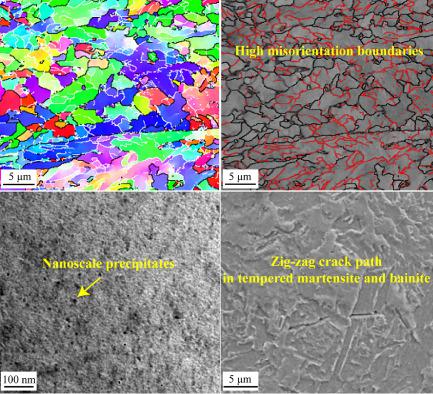当前位置:
X-MOL 学术
›
Steel Res. Int.
›
论文详情
Our official English website, www.x-mol.net, welcomes your feedback! (Note: you will need to create a separate account there.)
Significant Improvement in Strength and Toughness of Nanoscale Precipitate–Strengthened Steel by Direct Quenching and Tempering Process
Steel Research International ( IF 2.2 ) Pub Date : 2020-07-20 , DOI: 10.1002/srin.202000331 Jun Hu 1 , Kang-Kang Liu 1 , Li Ma 1 , R. Devesh Kumar Misra 2 , Wei-Na Zhang 1 , Han-Chen Du 1 , Wei Xu 1
Steel Research International ( IF 2.2 ) Pub Date : 2020-07-20 , DOI: 10.1002/srin.202000331 Jun Hu 1 , Kang-Kang Liu 1 , Li Ma 1 , R. Devesh Kumar Misra 2 , Wei-Na Zhang 1 , Han-Chen Du 1 , Wei Xu 1
Affiliation

|
Herein, the microstructural evolution and mechanical properties of a low‐carbon Nb–Ti–Mo‐bearing steel subjected to hot rolling followed by four different processing schedules (air cooling, direct quenching, low‐temperature tempering, and high‐temperature tempering) are studied to elucidate the significance of structural refinement and nanoscale precipitates for obtaining the optimized combination of strength and toughness. The microstructure of air‐cooled steel composed of coarse polygonal ferrite and granular bainite, and minimum yield strength of 473 MPa and lowest impact energy at −40 °C of 40 J are obtained. The microstructure of steel direct quenched and tempered at 520 °C consists of sub‐micron tempered martensitic and bainitic laths with a high relative fraction of high misorientation boundaries and high density of 3–5 nm (Nb, Ti, Mo)C precipitates, and maximum yield strength of 726 MPa and highest impact energy at −40 °C of 213 J are obtained. The formation of nanoscale precipitates coupled with fine tempered martensitic and bainitic blocks contributes to 253 MPa improvement of yield strength and more than five times enhancement of impact energy. The small blocks of tempered martensite and bainite can deviate and finally arrest the crack propagation, whereas the coarse polygonal ferrite and bainite provide inadequate resistance for crack propagation.
中文翻译:

直接淬火和回火工艺可显着提高纳米级沉淀强化钢的强度和韧性
在此,对低碳Nb-Ti-Mo轴承钢进行热轧,然后进行四种不同的加工程序(空冷,直接淬火,低温回火和高温回火)后,其组织演变和力学性能为:为了阐明强度和韧性的最佳组合,研究人员阐明了结构细化和纳米级沉淀物的重要性。得到了由粗大的多边形铁素体和粒状贝氏体组成的空冷钢的组织,最小屈服强度为473 MPa,在-40°C时冲击能量最低,为40J。在520°C的温度下直接淬火和回火的钢的显微组织由亚微米回火的马氏体和贝氏体板条组成,具有较高的相对比例和较高的取向差边界,并且具有3–5 nm的高密度(Nb,Ti,Mo)C沉淀,获得最大屈服强度726 MPa和在-40°C时的最大冲击能为213J。纳米级析出物的形成以及细化回火的马氏体和贝氏体块体,使屈服强度提高了253 MPa,冲击能量提高了5倍以上。回火马氏体和贝氏体的小块可能会偏离并最终阻止裂纹扩展,而粗大的多边形铁素体和贝氏体则不足以抵抗裂纹扩展。
更新日期:2020-07-20
中文翻译:

直接淬火和回火工艺可显着提高纳米级沉淀强化钢的强度和韧性
在此,对低碳Nb-Ti-Mo轴承钢进行热轧,然后进行四种不同的加工程序(空冷,直接淬火,低温回火和高温回火)后,其组织演变和力学性能为:为了阐明强度和韧性的最佳组合,研究人员阐明了结构细化和纳米级沉淀物的重要性。得到了由粗大的多边形铁素体和粒状贝氏体组成的空冷钢的组织,最小屈服强度为473 MPa,在-40°C时冲击能量最低,为40J。在520°C的温度下直接淬火和回火的钢的显微组织由亚微米回火的马氏体和贝氏体板条组成,具有较高的相对比例和较高的取向差边界,并且具有3–5 nm的高密度(Nb,Ti,Mo)C沉淀,获得最大屈服强度726 MPa和在-40°C时的最大冲击能为213J。纳米级析出物的形成以及细化回火的马氏体和贝氏体块体,使屈服强度提高了253 MPa,冲击能量提高了5倍以上。回火马氏体和贝氏体的小块可能会偏离并最终阻止裂纹扩展,而粗大的多边形铁素体和贝氏体则不足以抵抗裂纹扩展。


























 京公网安备 11010802027423号
京公网安备 11010802027423号